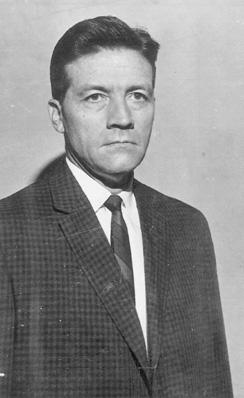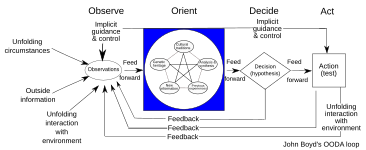John Boyd (military strategist) facts for kids
Quick facts for kids
John Boyd
|
|
|---|---|
 |
|
| Nickname(s) | Forty Second Boyd Genghis John The Mad Major The Ghetto Colonel |
| Born | January 23, 1927 Erie, Pennsylvania, US |
| Died | March 9, 1997 (aged 70) West Palm Beach, Florida, US |
| Buried | |
| Allegiance | United States |
| Service/ |
United States Air Force |
| Years of service | 1945-1975 |
| Rank | Colonel |
| Commands held | Task Force Alpha 56th Combat Support Group |
| Battles/wars | World War II Korean War Vietnam War |
| Awards | Legion of Merit (4) Air Medal (3) Harold Brown Award |
| Alma mater | University of Iowa Georgia Institute of Technology |
| Other work | Military strategist |
John Richard Boyd (born January 23, 1927 – died March 9, 1997) was a very important United States Air Force fighter pilot. He also worked as an advisor at the Pentagon, which is like the headquarters for the US military. His ideas changed how people thought about military plans, business, and even legal strategies.
John Boyd was part of a group called the Fighter Mafia. He helped create the Lightweight Fighter program, which led to famous planes like the General Dynamics F-16 Fighting Falcon and the McDonnell Douglas F/A-18 Hornet. With his friend Thomas Christie, Boyd also developed the Energy-Maneuverability theory. This theory helped design better fighter jets. He also came up with a famous decision-making idea called the OODA loop.
Contents
Early Life and Education
John Boyd was born on January 23, 1927, in Erie, Pennsylvania. He joined the Army Air Forces in October 1944 while still in high school. After graduating, he trained as an aircraft mechanic during the end of World War II.
From 1946 to 1947, Boyd worked as a swimming instructor in Japan. He became a sergeant and stayed in the Air Force Reserve while he went to college. He earned a degree in economics from the University of Iowa in 1951. Later, he got another degree in industrial engineering from the Georgia Institute of Technology.
Air Force Career Highlights
After college, Boyd became a second lieutenant in the Air Force. In March 1953, he arrived in Korea as an F-86 pilot. He flew 22 missions during the Korean War. He never fired his guns or shot down an enemy plane.
After Korea, Boyd was invited to the Fighter Weapons School. He was a top student and later became an instructor there. He led the academic section and wrote the school's tactics manual.
Boyd was known as "Forty Second Boyd." This was because he would bet that he could beat any pilot in air combat in less than 40 seconds, even if he started at a disadvantage. His biographer, Robert Coram, said Boyd was also called "The Mad Major" because of his strong feelings. He was also known as "Genghis John" for his direct way of talking and the "Ghetto Colonel" for his simple lifestyle.
During the Vietnam War, he served in Thailand from April 1972 to April 1973. He was the Vice Commander of Task Force Alpha.
Boyd's Military Theories
In the early 1960s, John Boyd and Thomas Christie, a mathematician, created the energy–maneuverability theory, or E-M theory. This theory was about how planes move in air combat. It became the worldwide standard for designing fighter aircraft.
Boyd's work helped improve the design of the McDonnell Douglas F-15 Eagle fighter jet. Even though the final plane was bigger than he wanted, his ideas helped make it a success.
The Fighter Mafia Group
Boyd, along with Colonel Everest Riccioni and Pierre Sprey, formed a small group called the "Fighter Mafia." They worked within the Air Force Headquarters. Riccioni was a fighter pilot, and Sprey was a statistician.
They disagreed with the direction the F-15 program was taking. Boyd suggested a different plane, a "Red Bird," that would be lighter and cheaper. It would be an air-to-air fighter for clear weather, focusing on maneuverability rather than top speed. This idea was not fully adopted for the F-15.
However, the Secretary of Defense liked the idea of a low-cost fighter. This led to funding for the Lightweight Fighter program (LWF), which later became the F-16. The F-16 was designed to cost no more than $3 million per plane. While the program grew into a multi-role fighter, it still had roots in Boyd's ideas.
OODA Loop: The Decision Cycle
One of Boyd's most important ideas is the OODA loop. This stands for Observe, Orient, Decide, and Act. It describes how individuals or groups react to events.
The OODA loop helps explain how to make quick decisions in fast-changing situations. It has been used in military strategy, business, and even legal planning. It helps people understand how to think and act faster than their opponents.
Aerial Attack Study
Boyd also changed how pilots thought about air-to-air combat. He wrote the Aerial Attack Study, which became the official tactics manual for fighter aircraft. Before this, pilots thought air combat was too complicated to fully understand.
Boyd's manual showed that pilots needed to know two main things: the enemy's position and their speed. By knowing the enemy's speed, a pilot could guess what moves the enemy might make. This helped pilots plan their own actions to counter the enemy.
Influence on Military Strategy
Boyd is given credit for largely developing the strategy for the invasion of Iraq in the Gulf War of 1991. In 1981, Boyd shared his ideas, called Patterns of Conflict, with US Representative Richard "Dick" Cheney.
By 1990, Boyd had moved to Florida due to his health. But Cheney, who was then the Secretary of Defense, called Boyd back to help plan Operation Desert Storm. Boyd had a big influence on the "left hook" design of the plan, which was a key part of the victory.
General Charles C. Krulak, a former leader of the Marine Corps, said that John Boyd was a key architect of that victory. He believed Boyd's ideas helped the Iraqi army collapse.
Maneuver Warfare and Marines
In January 1980, Boyd presented his Patterns of Conflict briefing at the US Marines AWS (Amphibious Warfare School). This led to changes in their training program. An instructor named Michael Wyly and Boyd worked together on this.
Wyly, along with Pierre Sprey, Raymond J. "Ray" Leopold, Franklin "Chuck" Spinney, Jim Burton, and Tom Christie, were known as Boyd's followers.
Later Career and Death
When John Boyd retired in 1975, the US Air Force gave him the important Harold Brown Award.
Boyd passed away from cancer in Florida on March 9, 1997, at the age of 70. He was buried with full military honors at Arlington National Cemetery on March 20, 1997. His burial site is Section 60, Gravesite 3066.
Awards and Decorations
During his long career, John Boyd received many awards and decorations for his service:
 |
|||
| USAF Command Pilot Badge | |||||||||||
| Legion of Merit w/ 3 bronze oak leaf clusters |
Air Medal w/ 2 bronze oak leaf clusters |
||||||||||
| Air Force Commendation Medal | Army Commendation Medal | Air Force Presidential Unit Citation | |||||||||
| Air Force Outstanding Unit Award w/ Combat "V" |
Army Good Conduct Medal | American Campaign Medal | |||||||||
| Asiatic-Pacific Campaign Medal | World War II Victory Medal | Army of Occupation Medal w/ 'Japan' clasp |
|||||||||
| National Defense Service Medal w/ 1 bronze service star |
Korean Service Medal w/ 2 bronze campaign stars |
Vietnam Service Medal w/ 1 bronze campaign star |
|||||||||
| Air Force Longevity Service Award w/ 1 silver oak leaf cluster |
Republic of Korea Presidential Unit Citation | Vietnam Gallantry Cross | |||||||||
| United Nations Service Medal for Korea | Republic of Vietnam Campaign Medal | Korean War Service Medal | |||||||||


